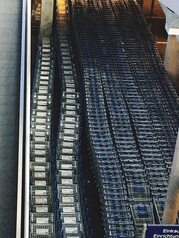Connectivity as a Driver of Your Investment Growth

Connectivity has become a key factor for the growth of your real estate investment. In a world where location is essential, the quality of digital and physical connections can make the difference between a stagnant property and one that thrives in appreciation. Discover how connectivity not only enhances your quality of life but also multiplies the value of your investment in the long term. Don't underestimate its impact; your financial future could depend on it!
The importance of connectivity in the real estate market
Connectivity has become an essential element in the real estate market, not only for the ease of access to services and resources but also for its direct influence on property valuation. Areas with a strong transportation infrastructure, as well as access to high-speed internet, tend to attract more residents and businesses. This creates a dynamic environment that drives demand for housing and commercial spaces, resulting in a significant increase in property value. In this sense, investing in properties located in areas with good connectivity becomes a smart strategy for those looking to maximize their return.
In addition to facilitating mobility and access to essential services, digital connectivity has become crucial for modern households. The ability to work from home or study online makes families increasingly value the quality of available digital connections. Properties that offer advanced technological solutions, such as fast Wi-Fi networks and smart home systems, stand out from less equipped ones. This shift not only leads to an improvement in the quality of life for residents but also has the potential to increase the property's value as these features become more sought after by future buyers and tenants.
2. Digital connectivity: The new standard for buyers
Digital connectivity has evolved from being a luxury to becoming an essential need for property buyers. In the current era, where remote work and virtual communications are an integral part of our lives, having access to high-speed internet and digital services is a decisive factor for many people when choosing their home. Real estate developments that offer solutions such as robust Wi-Fi networks, home automation systems, and spaces designed to facilitate remote work not only attract more interest but also perform better in the market, ensuring a significant increase in their value.
Moreover, digital connectivity directly impacts the quality of life of residents. A well-connected neighborhood not only allows for enjoyment of entertainment and education through online platforms but also facilitates access to essential services such as health and urban mobility. This type of infrastructure not only makes a property more attractive to potential tenants or buyers but also contributes to the sustainable development of the area. Thus, investing in properties with good digital connectivity translates into a safe bet for those looking to maximize their long-term investment.
3. Road infrastructure: Key in property valuation
Road infrastructure is a fundamental component in the valuation of properties, as it establishes the basis for effective connectivity between different points. The quality and condition of the roads not only affect the daily mobility of residents but also directly influence the appreciation of real estate value. Properties located near main roads, highways, or public transportation systems tend to be more attractive to buyers and renters, which generates a constant demand and, consequently, an increase in their value. In this sense, good road infrastructure can transform previously undervalued areas into prosperous zones.
In addition to facilitating access to essential services such as schools, hospitals, and shops, an efficient road network contributes to improving the quality of life for residents. This translates into a more desirable environment that attracts both tenants and potential buyers. Properties located in areas with good connectivity are not only easier to sell or rent but also tend to maintain their value during uncertain economic periods. Therefore, when considering a real estate investment, assessing road infrastructure should be a priority; it is a clear indicator of the future potential for appreciation and economic growth in the area.
4. Urban projects and their influence on connectivity
Urban projects are a tangible manifestation of the development and modernization of cities, and their influence on connectivity is undeniable. When works such as new public transport lines, technology parks, or shopping centers are implemented, not only is the physical infrastructure improved, but digital connectivity is also enhanced. These projects promote a more accessible and efficient environment for residents and local businesses, which in turn attracts new investors interested in leveraging the constant flow of people and resources. The synergy between urban infrastructure and technology creates an ecosystem where properties can experience a significant increase in their value.
Moreover, when considering specific projects such as economic development zones or initiatives to improve access to high-speed internet, it is evident that these efforts directly impact the quality of life of citizens. Areas with good connectivity tend to become attractive hubs for entrepreneurs and professionals seeking to establish their businesses or reside in places with better services. This creates a growing demand for well-located properties within these revitalized urban areas, which not only increases interest from potential buyers but also opportunities to lease at competitive prices. Investing in areas with active urban projects can be a smart strategy to ensure sustained appreciation in your real estate investment.
5. Analysis of the economic impact of good connectivity
The economic impact of good connectivity in the real estate sector is undeniable. A property that has access to high-speed internet and efficient transportation connections not only attracts more potential buyers but also increases its market value. Well-connected areas often experience a rise in demand, which translates into sustained appreciation. Owners can benefit directly by having a greater number of interested parties, which can lead to more favorable negotiations and quick sales at competitive prices.
Additionally, good connectivity fosters an environment conducive to local economic development. Companies are more willing to establish themselves in areas where digital and physical infrastructure is robust, generating employment and energizing the regional economy. This creates a virtuous circle: as new businesses arrive, the population increases, and therefore, the demand for housing rises. Investors can see how their properties not only maintain their value but also appreciate due to economic growth driven by effective connectivity. In summary, investing in well-connected properties not only improves your quality of life; it also represents a smart strategy to maximize your long-term financial returns.
6. How to evaluate connectivity before investing
Before making a real estate investment, it is crucial to assess the connectivity of the area. This involves not only considering access to public transport networks and major roads, but also the quality of internet access and the available technological infrastructures. In a world where remote work and online education are becoming increasingly common, having a high-speed connection can be a decisive factor in attracting potential tenants or buyers. Thus, researching service providers and reviews from current residents will give you a clear idea of the actual connectivity of the area.
It is also important to observe how connectivity influences other aspects of the environment. Well-connected areas tend to benefit from increased commercial and social flow, which in turn can enhance the value of your property. Checking for future plans to improve infrastructure or expand technological services is essential; these developments can translate into a significant increase in the value of your long-term investment. Therefore, conducting a thorough analysis of connectivity not only optimizes your current decisions but also ensures sustainable growth for your financial future.
7. Future connectivity trends you should consider
Connectivity is constantly evolving, and to keep your investment at the forefront, it is crucial to stay informed about the trends that will shape the future. One of the most prominent is the implementation of 5G and the expansion of fiber optic networks, which promise to deliver unprecedented internet speeds. This will not only benefit residents by allowing them to enjoy a smoother digital experience but will also attract tech companies and entrepreneurs looking for strategic locations to establish themselves. The ability to connect quickly and without interruptions will become a decisive factor for those seeking to rent or buy properties.
Another key trend is the rise of the Internet of Things (IoT), where smart homes will increasingly integrate into our daily lives. From security systems to smart thermostats, these devices not only enhance energy efficiency but also increase the overall appeal of a property. Homes that incorporate IoT technology will be better positioned in the market, as modern buyers value convenience and connectivity as essential attributes. Adapting your real estate investment to these trends not only optimizes its current value but also ensures its future relevance in an increasingly interconnected world.
8. Successful cases: Investments that grew thanks to connectivity
Connectivity has proven to be a key driver in the growth of real estate investments, with multiple cases illustrating its positive impact. In various cities, residential developments that have incorporated high-speed internet access and efficient transportation networks have seen a notable increase in their value. For example, projects located near subway stations or bus stops that offer fast connectivity not only facilitate mobility but also attract tenants and buyers interested in convenience and accessibility. This translates into higher demand and, consequently, an appreciation in property prices.
Another successful case is that of smart communities that have integrated advanced technology to offer connected services to their residents. These initiatives not only enhance the quality of life by facilitating everyday tasks such as energy management or smart home control but also increase the attractiveness of the property in the market. Properties in these areas tend to experience a significant increase in their value due to the perception of modernity and sustainability. Thus, investing in places with high connectivity becomes a smart strategy for those looking to maximize their long-term financial return.



